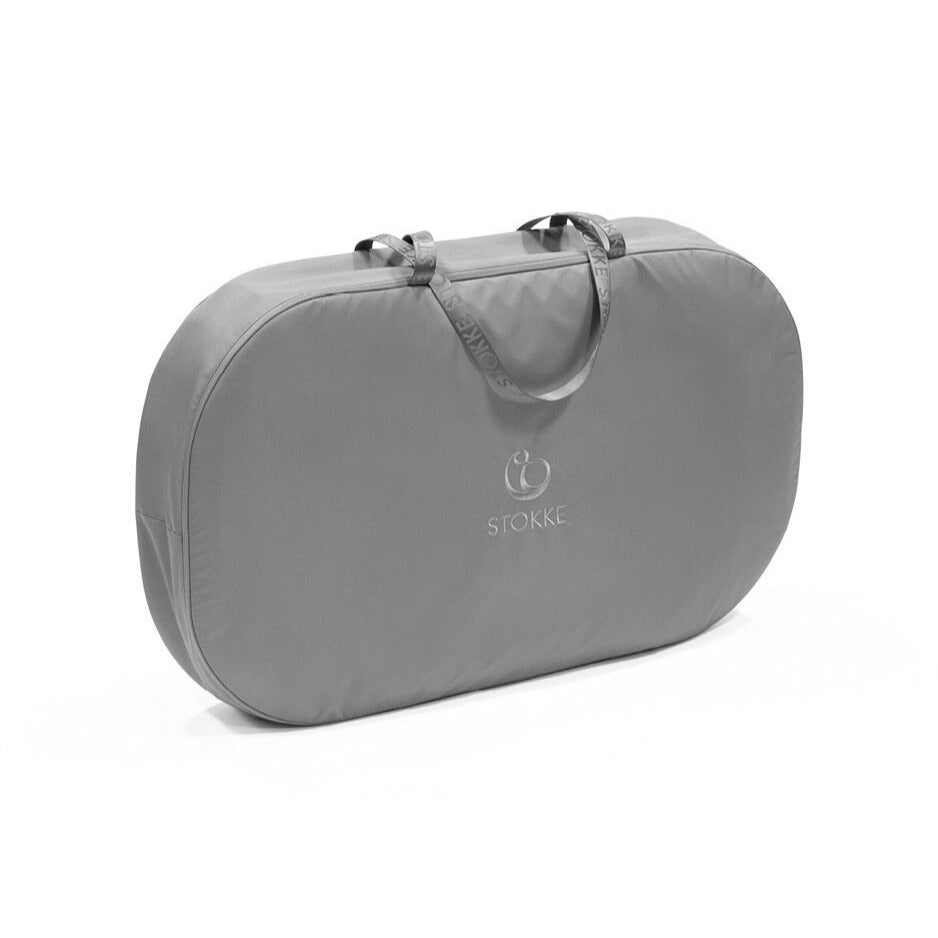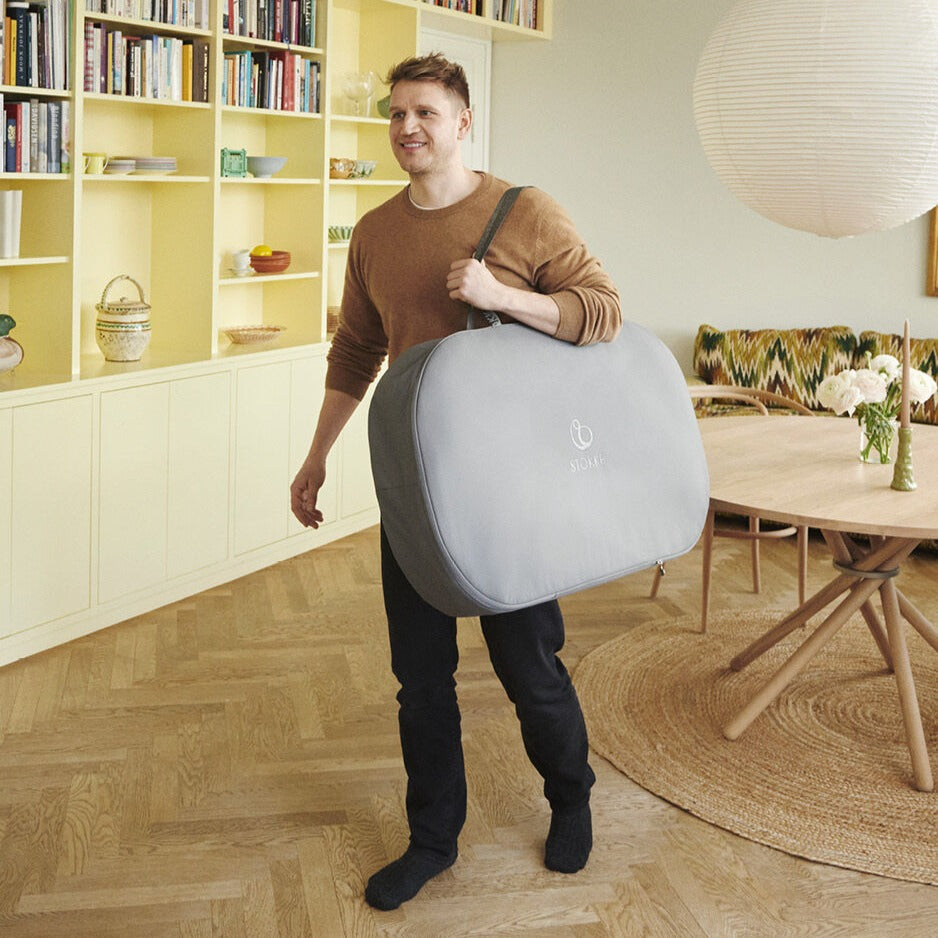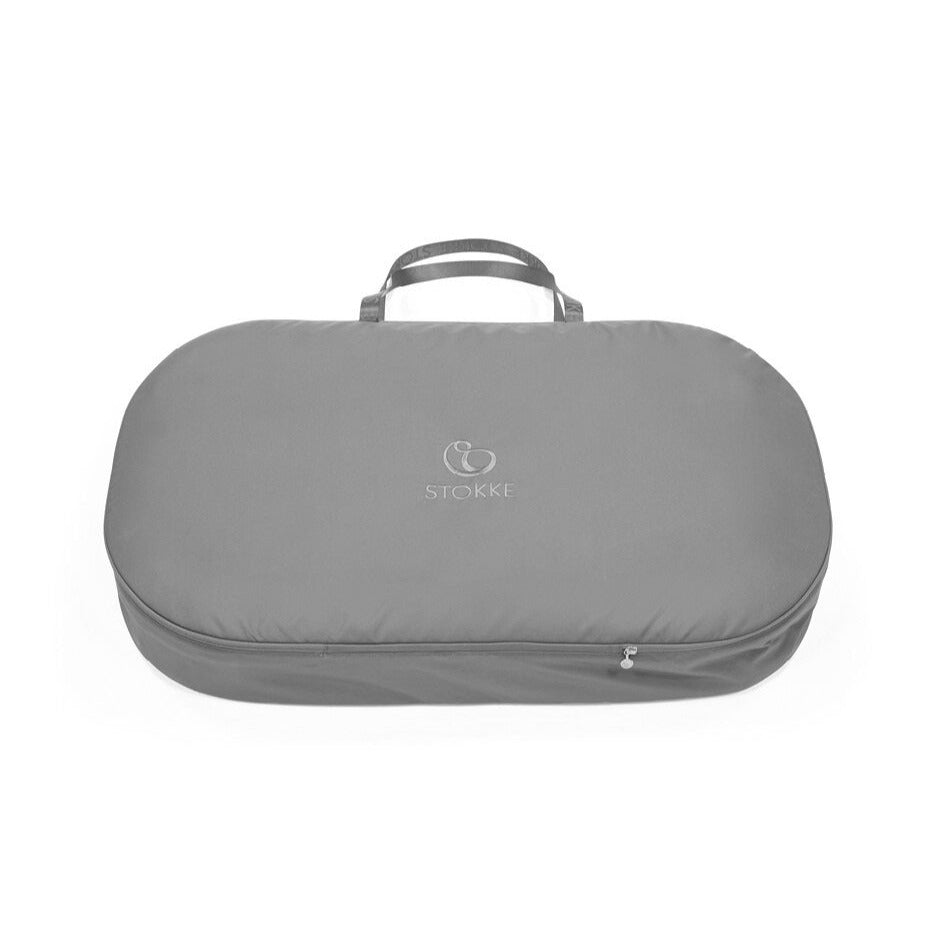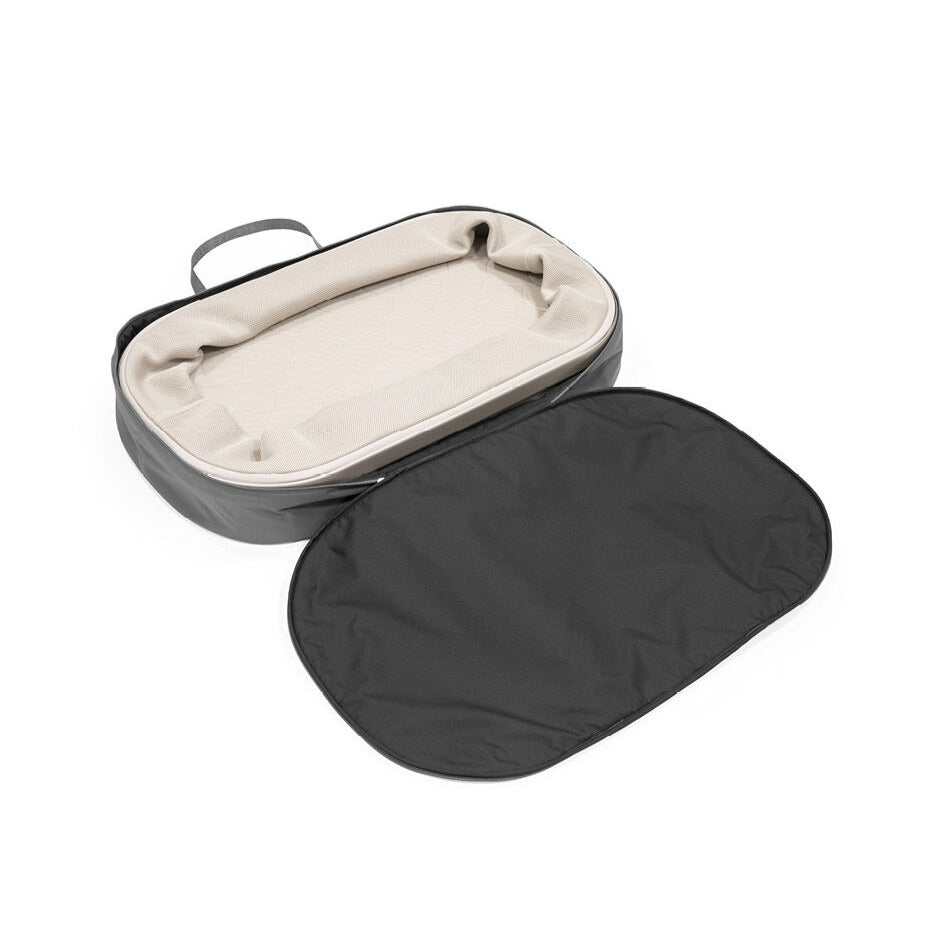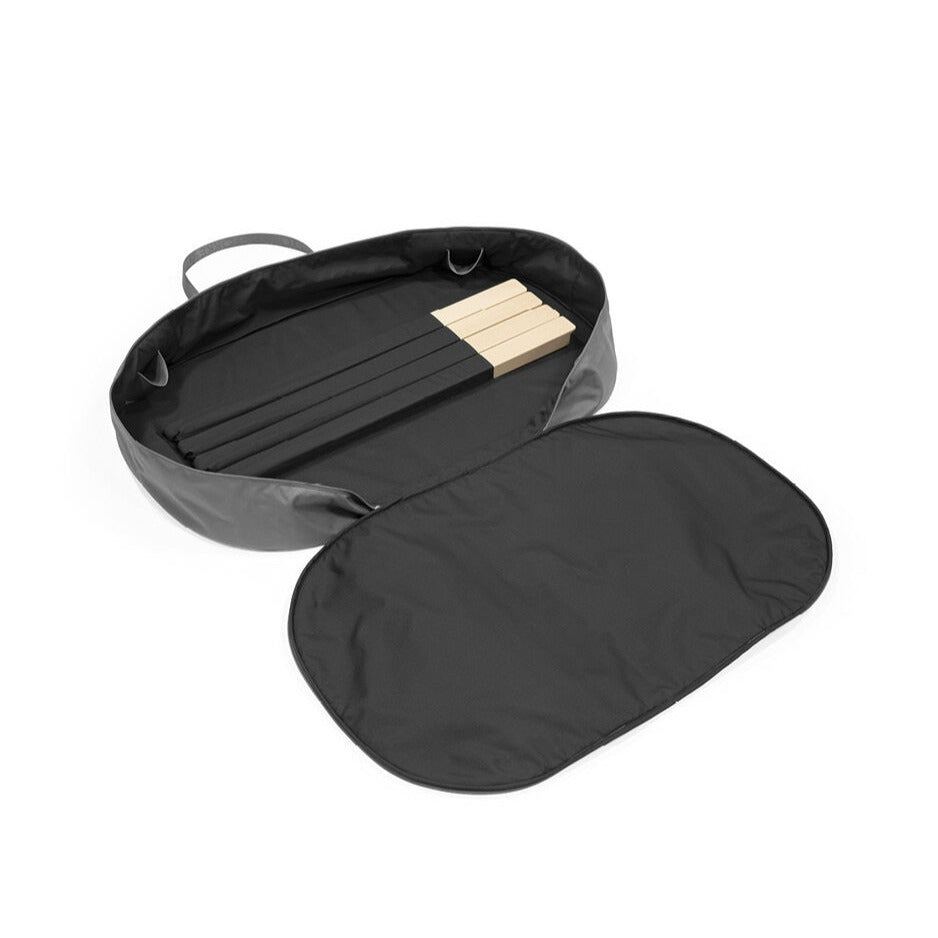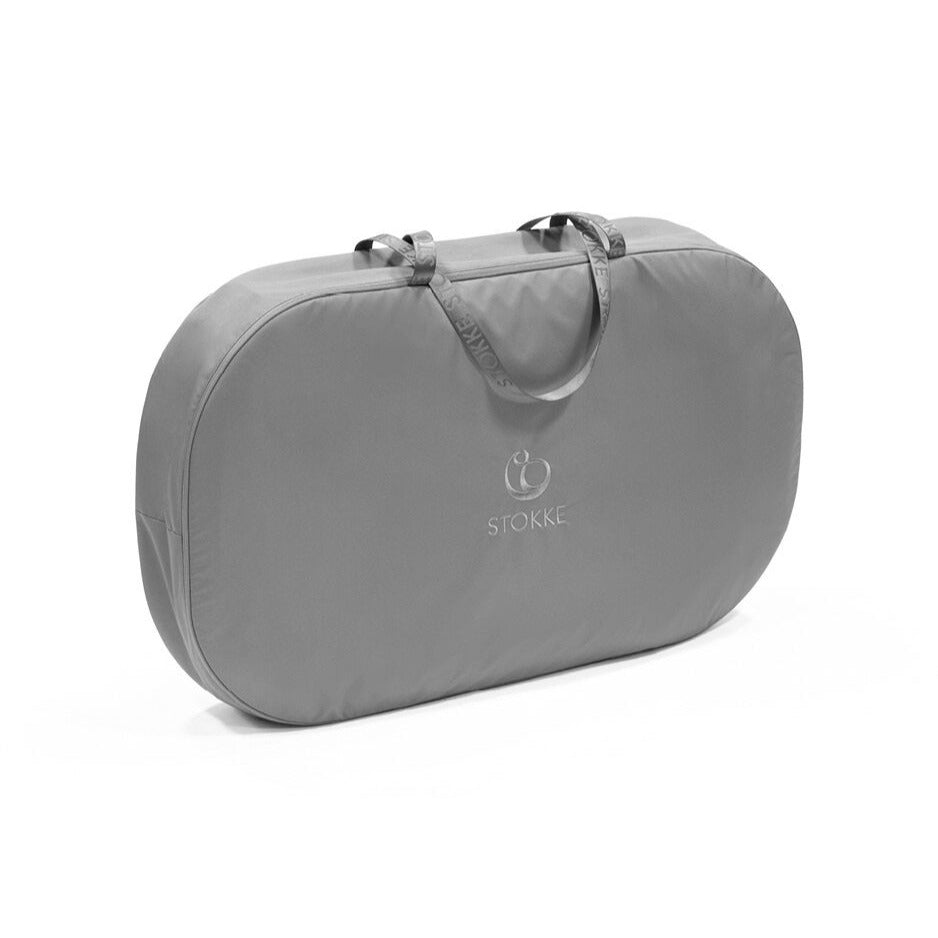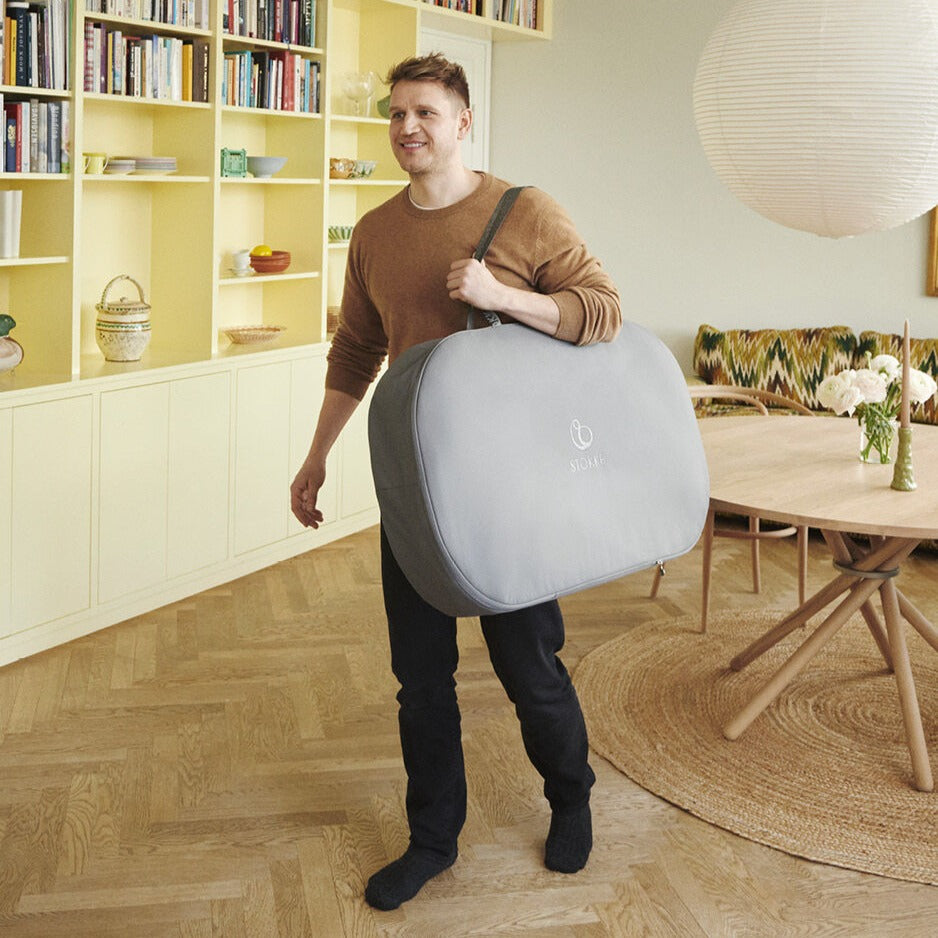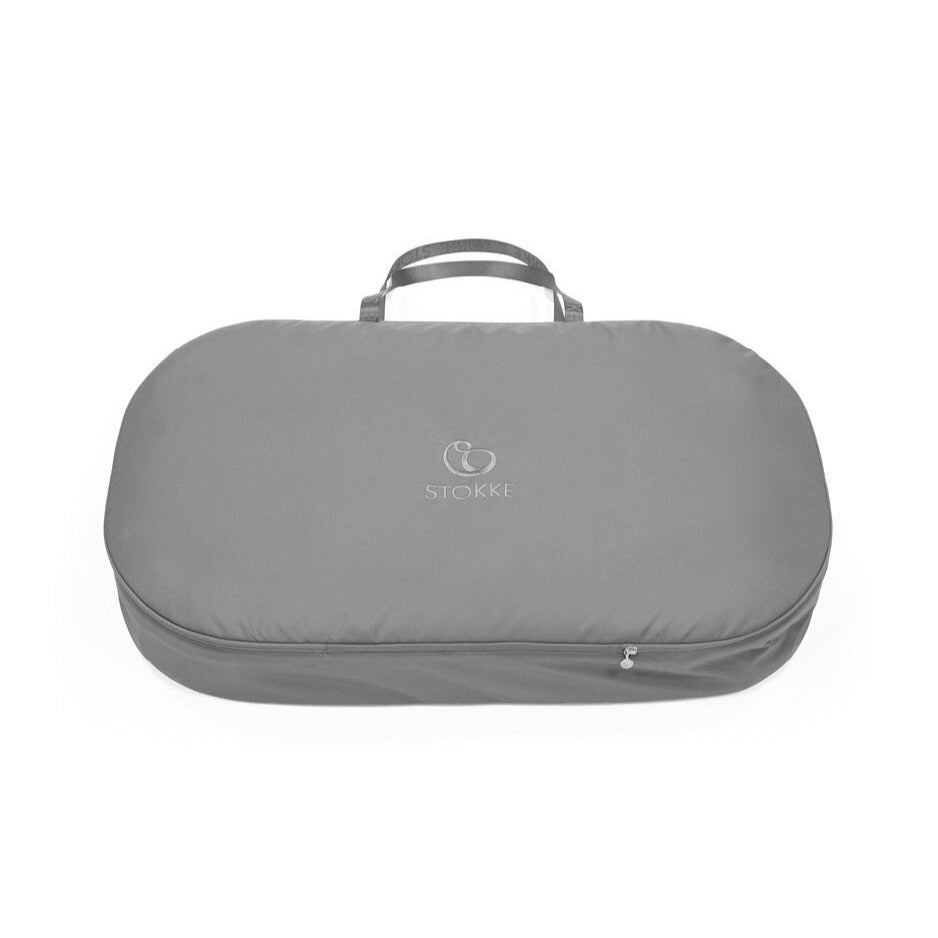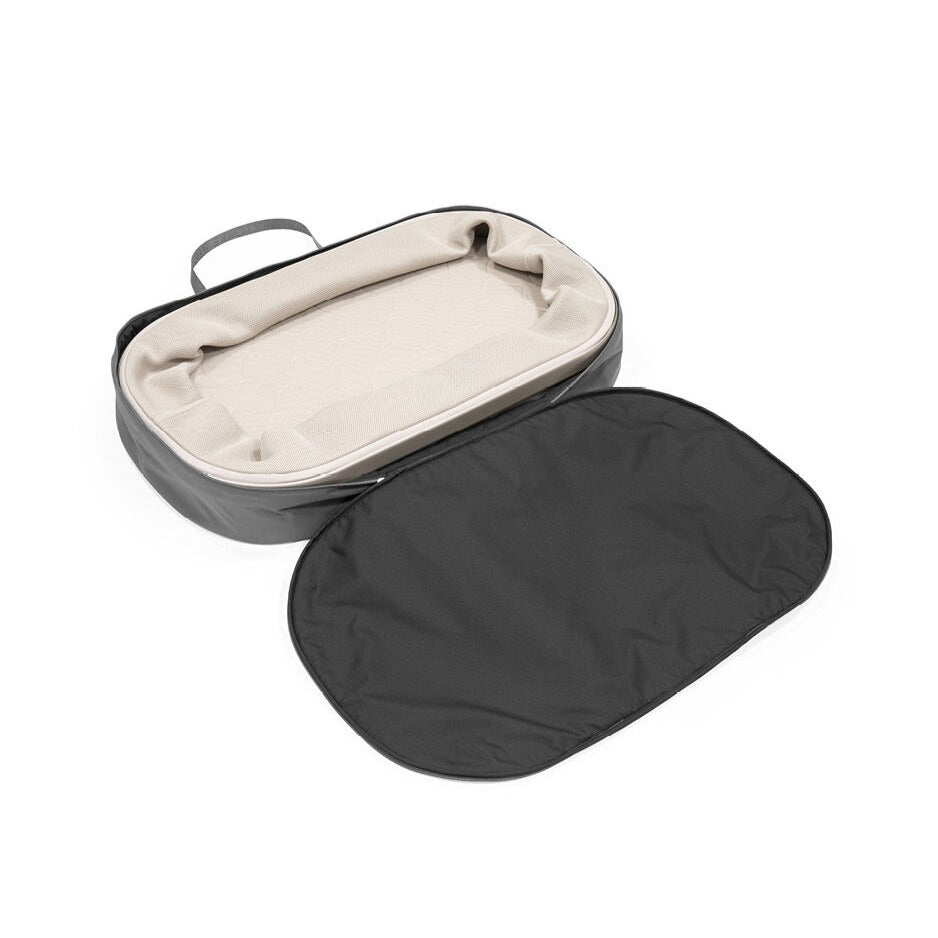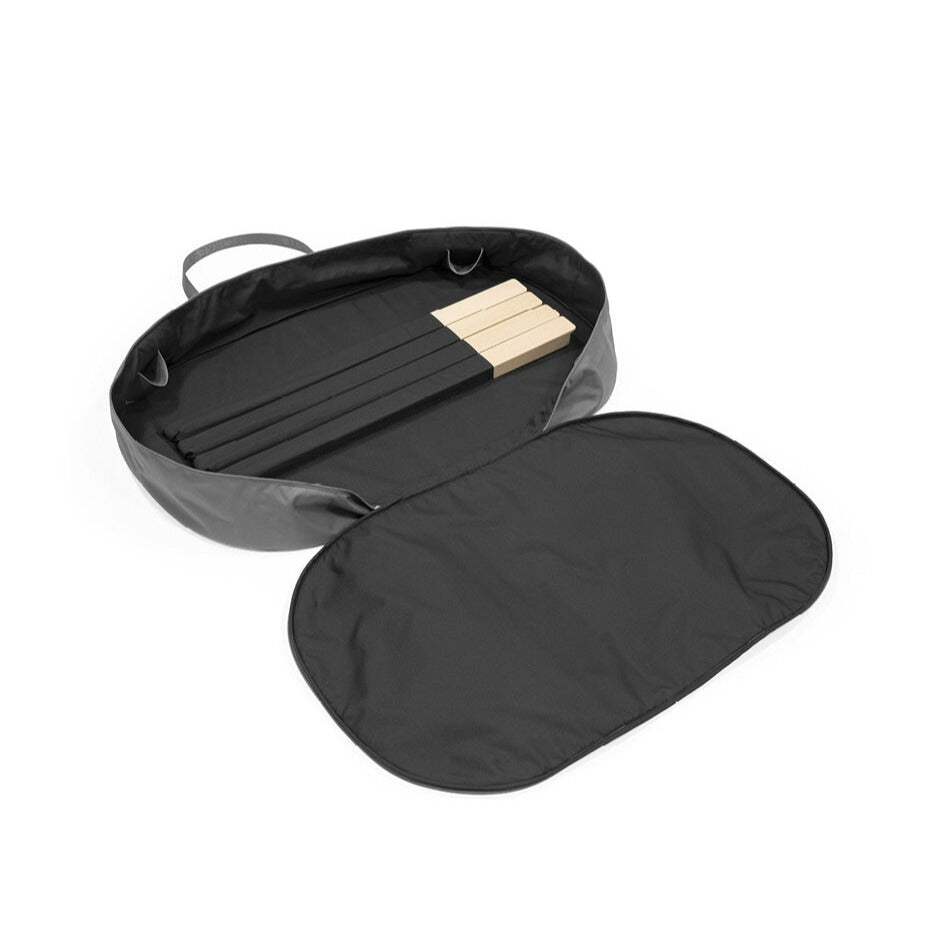Stokke Snoozi Bag
Stokke Snoozi Bag
SKU:630001
Low stock
Couldn't load pickup availability
Overview
Overview
Perfect for families on the go, the Stokke® Snoozi™ Bag is essential for travel and storage. Crafted from high-quality, PFC-free polyester, this bag offers robust protection for your Stokke® Snoozi™ bassinet. It features a convenient carry handle and a trendy webbing strap for easy one-shoulder carrying. The bag includes separate pockets to store the bassinet legs and a large zipper for quick access, making it easy to pack and unpack.
Travel with peace of mind knowing your Stokke® Snoozi™ bassinet for baby is protected and ready for any adventure.
What's Included
What's Included
Technical Specification
Technical Specification
User Guide
User Guide
Delivery and Returns
Delivery and Returns
- Delivery: Free within NZ on orders over $100 (excluding bulky items) or $8 standard shipping
- Returns: Accepted within 14 days of receipt with proof of purchase
- Some items are excluded from returns including sale items, hardware, car seats, prams, monitors and personal items - please click here for the full list.
Share this product
Recently Viewed Products
Related Blogs
From Hobby to 'Family' Business
As the first few of her fourteen children came along, our founder Jane Anne McAllister found that store-bought clothes just didn’t have the quality she wanted for her babies. They also lacked the strength to endure being passed from one baby to the next and still look good, or even stay intact. So she sourced the best fabrics and began making her baby clothes, lovingly embroidering each item by hand. That was the start of Dimples. Founded in 1992, today, we still dedicate the same care and time that Jane gave to those first garments. We’re one of the few clothing companies that still manufacture in NZ, which lets us make sure each garment is of the highest quality. It also means that our manufacturing is inherently ethical – no unknown, offshore factories with little oversight of working conditions, wages or environmental issues. So who makes our clothes? Our sewing machinists are part of our family, and all highly-skilled craftspeople. Karen has been with us for about seven years, putting her five decades of experience into every garment. Meet Karen – a Dimples sewer As a teenager, Karen finished school in December and reached school-leaving age in January, with dreams of training as a hairdresser. Her parents had other ideas – the hairdressing job didn’t start until mid-February, and they weren’t having her underfoot with nothing to do all that time. “I had to do what my parents told me to. So they marched me into town and got me a sewing job, and that’s where I stayed. I started in the city – 50 years ago. Yes, it was a craft.” ‘Made-in-NZ’ – an endangered species Back when Karen started her working life, a trained machinist could walk out of one job and into another almost immediately. That’s changed now. Textile, leather, clothing and footwear manufacturing make up only 5% of New Zealand’s manufacturing sector, down from 8% in 2008. [1] The number of jobs filled by paid employees in the clothing and knitted-product manufacturing industry fell nearly 60 percent – from 9,550 to 4,120 between 1986 and 2012 [2] . Taking pride in the quality As a professional machinist, Karen says the shift towards international production might make clothes cheaper, but they’re often very poorly constructed. The difference, she says, is that she was trained to complete a whole garment rather than doing piece-work. International garment factories tend to have a group of people just sewing collars, cuffs or hems, for example. “Everything’s done on the big stitch, no back-tacking. Within weeks the seams come apart.” At Dimples, we can turn out high-quality garments because we employ craftspeople like Karen – they have very high standards and the skills to back it up. Karen, in particular was known for her precision and was often used as a sample machinist. “Everything had to be spot on. It was an example – then other sewers had to make it exactly like the sample.” The Dimples family The inclusive culture we foster at Dimples helps our engaged and committed staff produce their best work in a happy, supportive atmosphere. Karen truly thinks the Dimples ‘family’ are lovely people to work for. “I’ve worked for a lot of people, and some of the other bosses were terrible. But Jane is just fantastic. When my grandkids were born, I got a beautiful gift for each baby. At Dimples, they care about you. They’re just nice people.”
Learn moreTips & Tricks for Travelling with a Baby or Toddler
Travelling with Kids: Your Fun, Fuss-Free Guide Heading off on a family adventure? Travelling with little ones can be full of magical memories – but let’s be honest, the planning and packing can feel a bit overwhelming. We’ve put together some handy tips and a comprehensive checklist to help make your trip smoother (and a lot more fun!). 🏖️☀️ Before You Go: Planning Ahead Research your destination: Does your accommodation provide a cot, high chair, or other baby-friendly gear? Think about how you’ll get around too – will you need car seats or airport transfers? Book smart: When booking flights, don’t forget the extras. Request a bassinet if needed, look for seats with extra legroom, and pre-order kids’ meals. Check your airline’s baggage policy and what baby gear you can bring. Get your documents sorted: Make sure everyone’s passports are up to date (including baby’s – with at least 6 months’ validity). Don’t forget visas and any required immunisation records. Getting There: In-Flight Tips Arrive early: Give yourself extra time to get through the airport stress-free. Take advantage of priority boarding – it gives you a few bonus minutes to settle in before the crowd. Ears and altitude: Offer a bottle or breastfeed during takeoff and landing to ease pressure on their ears. A pacifier or sippy cup can also help. Keep boredom at bay: New toys or books they haven’t seen before can work wonders – try magnetic books, sticker books, or even a stack of post-it notes for endless sticking fun. Load up your device with baby-friendly apps or videos for those moments a toy just won't do. Snacks, snacks, snacks: Pack food you know they love – and plenty of it! Snacks can be both fuel and entertainment. Once You Arrive: Making the Most of the Holiday Stick (loosely) to routine: Keeping to familiar nap and mealtimes can help your little one adjust. But travel rarely goes perfectly to plan, so go with the flow where you can. Baby-proof your space: Once you get to your accommodation, do a quick scan of the room. Move anything hazardous out of reach so you can relax and enjoy your time away. Stay cool and sun-safe: Keep fluids up and protect sensitive skin with sunscreen, sunhats, and breezy clothing – especially in tropical destinations. Your Ultimate Packing Checklist (with links to products we love!) Important Documents: Passports and visas Luggage ID tags (don’t forget to label strollers and baby gear too) Travel insurance Carry-On Essentials: Nappies and wipes (pack more than you think you’ll need) Disposable change mats - super handy for when you're on the go Spare clothes for baby and you Swaddle or blanket Pacifier and a favourite cuddly toy Snacks and meals Bottles and formula (if needed) Baby-safe hand sanitiser - we love this one from Paume Toys and books Tablet with headphones Baby carrier for hands-free travel For older toddlers, consider the Jetkids Bedbox by Stokke – a ride-on suitcase that converts into an inflight bed! Baby Gear & Equipment: A compact travel stroller (like the YOYO) that fits in overhead lockers is a game-changer Travel cot if your accommodation doesn’t provide one – bonus as it doubles as a play space! For bigger kids, the Stokke Cloud Sleeper inflatable bed is a great option White noise machine - we love the Yogasleep Hushh Stroller fan for warm climates Insect nets for cot and pram Car seat – different countries have different rules, so it's very important to research ahead. We recommend the Maxi-Cosi Nomad for its light weight and compact size (suitable from approx. 15 months to 4 years) Portable blackout blinds for the room, or even a stroller shade to help with daytime naps Clothing & Accessories: Weather-appropriate clothes, including wet bags for damp items Sleep sacks (bring one your child is used to, and adjust for warmer/cooler climates) Sun protection – sun hats, sunglasses, and lightweight layers Feeding: Bottles or sippy cups Enough formula or food for the trip (plus some spares) Bibs, burp cloths, and baby-safe detergent Changing, Hygiene & Health: Nappies and wipes (pack for a few days, then restock locally) Sunscreen and insect repellent Baby-safe medication, thermometer, and first aid basics Travel-sized toiletries and nappy cream Once you’ve nailed your list, save a copy for next time. A notes app on your phone works perfectly! Bon voyage and happy travels with your mini adventurers! ❤️
Learn moreTemperature Control and Sleep
Hot and cold – helping your baby sleep comfortably We all know how much temperature affects sleep. Too hot and you’re tossing the covers off, too cold and you’re hunting for another blanket. For babies, who are still learning to regulate both their body temperature and sleep patterns, the impact can be even greater. If they’re too warm or chilly, they might struggle to drift off – or wake more often through the night. The good news is you can help keep your baby at a comfortable temperature with the right mix of clothing, bedding, and room adjustments, making it easier for them to settle and stay asleep. Why temperature matters Our bodies can regulate internal temperature, but during deep sleep, that process slows down. This means a room that’s too hot or too cold can cause night wakings. For babies, the ideal room temperature is around 18°C – it might sound cool, but a lower core temperature is linked to better sleep, while warmer conditions often mean more restlessness. A warm bath before bed can also help. While it seems backwards, the water on your baby’s skin will cool them down after the bath, helping them start the night at a comfortable temperature. Ways to manage temperature Heaters, fans, air conditioning, and the right bedding can all help keep things steady through the night. If you have a thermostat, set it to 18°C and let it do the work. If not, you can buy a plug-in thermostat for your heater to help maintain consistency. Merino – your sleep-time secret When it comes to baby sleepwear, merino wool is a year-round winner. Naturally breathable and temperature-regulating, it helps keep your baby comfortable in both warm and cool conditions – and research shows it can even help them sleep longer. In winter, use merino layers under a merino sleeping bag or sleepwalker. In summer, lighter cotton or merino sleepwear with a lighter weight sleeping bag is usually enough, depending on the temperature where you are. Sleeping bags are especially useful as they can’t be kicked off like blankets, keeping your baby covered all night. Choose one with a weight (or TOG rating) that suits the season. Spotting temperature troubles Signs your baby might be too hot: Waking often Sweaty neck or back Damp hair Rapid, shallow breathing If you notice these, remove a layer of clothing, switch to a lighter sleeping bag, improve airflow, or lower the room temperature. If your baby seems uncomfortably hot, check for fever and use a cool, damp cloth on their forehead and back. Signs your baby might be too cold: Moving around the cot more than usual Rolling onto their stomach during sleep Frequent short naps Early morning waking (around 5am, when body temperature naturally dips) If this happens, add a layer, switch to a warmer sleeping bag, or adjust the room temperature. Getting the temperature right won’t solve every sleep challenge, but it’s one piece of the puzzle that can make nights smoother for everyone. Click here to shop our full range of merino.
Learn moreSummer Sleep
Keeping your baby safe and comfortable when it’s hot Summer brings holidays, beach trips, swims and sunshine – but it also brings higher temperatures, which can be hard on your baby’s sleep. Make sure you’re ready by organising your baby’s room, sorting out summer clothing and bedding, and being aware of summer sleep safety while you’re out and about. Cool, comfortable, controlled Babies sleep best at 18-20 degrees Celsius (use a room thermometer to keep track). In the summer months, a baby’s room can rise above this temperature very quickly, even without direct sunlight. Fortunately, there are a few ways to keep your baby’s bedroom cool and comfy. If you have air conditioning or a heat pump with cooling function, simply set it at the right temperature before baby’s bedtime, so the room has time to cool down. If you don’t, a small fan can help with temperature and airflow – just don’t point it directly at your baby. Bonus – the noise of a fan can help some babies drift off. You can also keep the temperature down by leaving the windows open and curtains closed – this lets air circulate, but keeps sunlight out. Just remember to use mesh screens to prevent mosquitoes and other insects coming in. The best baby bedding Summer bedding is pretty straightforward. You’ll need light cotton sheets for the cot, bassinette, or Moses basket, and not much else. Depending on the temperature, your baby may need a cotton top sheet or a light muslin sleeping bag as well. Avoid synthetic fabrics, as these don’t breathe, and can make babies sweaty and uncomfortable. If your baby is very young and still needs to be swaddled, use a thin cotton or muslin swaddle , and consider leaving their legs free to regulate temperature. As always, keep unnecessary toys and blankets out of the bed. Clothing choices For clothing, think loose, light, and cotton. Depending on the heat in your house, your baby can sleep in just a nappy and singlet, or a light sleepsuit. Avoid synthetics, and keep everything loose and breathable. If you’re not sure, check the back of your baby’s neck – if it’s sweaty or hot, remove a layer of clothing or bedding. Out and about Summer means outings and disrupted sleep schedules. If your baby is happy to sleep in the pram or car, you’re lucky – but don’t forget to think about the temperature. Prams can get hot and airless very quickly, so park yours in the shade if your baby is asleep. Carry a mesh pram cover or light muslin throw for extra shade, but always leave an opening to allow air to circulate in the pram. Never use a heavy blanket or cover, as this could prevent airflow – which can be dangerous. In the car, use a sunshade over the window to keep direct sunlight off your baby’s skin. Crack a window or use the air conditioning to keep air flowing inside the car, and never, ever leave your baby asleep in the car alone. The temperature can rise to dangerous levels extremely quickly, even with a window open. Keeping your baby cool and comfortable should help them sleep better and feel happier during the day – so you can both enjoy the fun parts of summer. Get sorted for summer with Dimples’ range of clothing, bedding, and sleep accessories.
Learn more

